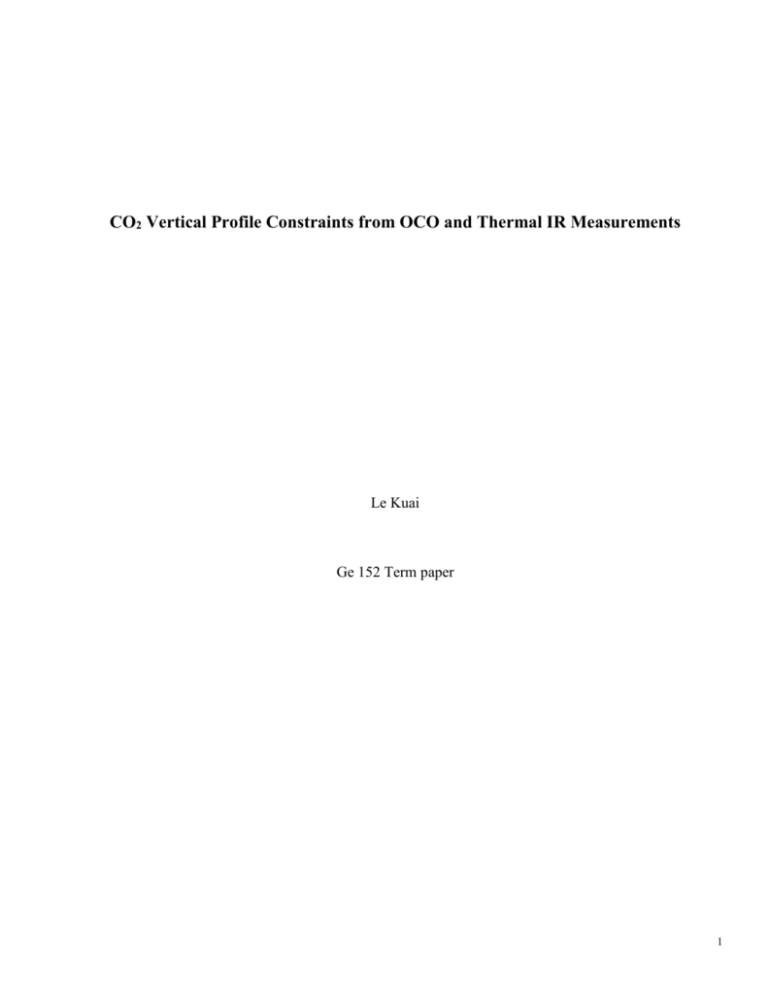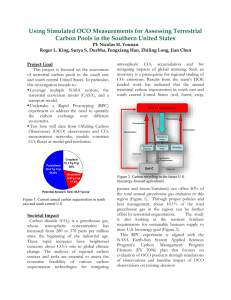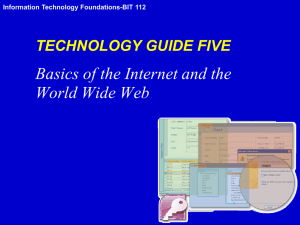termpaper
advertisement

CO2 Vertical Profile Constraints from OCO and Thermal IR Measurements Le Kuai Ge 152 Term paper 1 Abstract Understanding changes in atmospheric carbon dioxide (CO2) concentrations, their global sources and sinks, and the carbon cycle dynamics and processes that control their variability has emerged as one of the principal challenges of 21st century Earth system science. Satellite observations of atmospheric CO 2 are poised to revolutionize our understanding of global carbon cycle science by providing unprecedented spatiotemporal resolution and coverage. Major advances are expected with the launch of the Orbiting Carbon Observatory (OCO) in 2009. Here, we carry out an information analysis for a combined retrieval of OCO and thermal IR data (e.g. TES; the principle is same for AIRS data). Preliminary results show that there is considerable increase in the information content and degrees of freedom in the combined retrieval compared to retrieval using only OCO or only TES data. This approach will significantly improve the estimation of atmospheric carbon sources and sinks by providing observational constraints on vertical as well as horizontal and temporal distributions of atmospheric CO2 in data assimilation and data fusion approaches. 2 Introduction Carbon dioxide (CO2) is the second important green house. Its atmosphere concentration rapidly increases from 280 to 37 parts per million (ppm) within last 40 years. However, the geographic distribution of sourcesink for these CO2 and their variations are not well understood. The Orbiting Carbon Observatory (OCO) will for the first time provide global, space-based observations with high spatial resolution and high accuracy to identify CO2 sources and sinks and quantify their variability over the seasonal cycle [Crisp, et al., 2004]. The measurement of CO2 from space has dramatically improved spatiotemporal coverage. It will measure reflected sunlight in three near-infrared spectral regions (the 0.76 µm O2 A-band and in the CO2 bands at 1.61 and 2.06µm). The 3-band spectrometric approach using NIR reflected sunlight has the capability for highly accurate Xco2 measurements [Kuang, et al., 2002]. Tropospheric Emission Spectrometer (TES), launched aboard the Aura spacecraft in 2004, is a Fourier Transform spectrometer measuring infrared spectral radiances from 3.2 to 15.4 microns. TES observes thermally active atmospheric or surface quantity. TES data routinely provides vertical profiles of the following: Ozone, Carbon monoxide, Temperature, Water vapor, HDO, Emissivity, Effective cloud parameters, Cloud optical depth, and Cloud height. The principle is same for AIRS data. 3 (a) (b) Fig. 1 (a) OCO weak CO2 band in NIR region; (b) TES strong CO2 band in Thermal (a) (b) (c) Fig. 2 Averaging kernels for OCO retrieval (a), TES retrieval (b) and simultaneous retrieval (c) 4 Using the OCO weak CO2 band (1.62 µm, Fig. 1(a)) in the NIR region for the CO2 retrieval, the averaging kernels have peaks near surface (below 5 Km) (Fig. 2(a)). For TES retrieval, we use strong CO2 band (15 µm, Fig. 1(b)) in thermal infrared spectra. Thus, the peaks of TES averaging kernel are in middle and upper troposphere (between 5 to 15 Km, Fig, 2(b)), which is very similar to AIRS retrieval. A simultaneous retrieval of OCO and TES (or AIRS) will combine these pieces of complementary information. Fig. 2(c) shows that the joint retrieval averaging kernel for levels below 5 Km retain the structure of OCO averaging kernels. While the averaging kernels at levels of 7, 9 and 11 Km have peaks at middle and upper troposphere but are not zero at surface. Whether there will be benefit from the simultaneous retrievals of OCO and AIRS satellite observations can be investigated by the information analysis. Information Analysis In information theory, the Shannon entropy or information entropy is a measure of the uncertainty associated with a random variable. Self information is a measure of the information content (H) associated with the outcome of a random variable. It is in a unit of information, for example bits, nats or hartleys. In the measurement space, the information content is the difference between the entropy of the prior estimate of y and the posterior estimate Rodgers, 2000]. The degrees of freedom (ds) for signal describe the number of useful independent quantities [Rodgers, 2000]. It is a measure of information. The relations between information content, degrees of freedom for signal, the singular values of K and the averaging kernel matrix are showed below: 5 ˆ 1 I n A (K T S1K S a1 )S a1 SS a 1 1 2 H i ln(1 i ) ln I n A 2 2 d s i i2 /(1 i2 ) tr ( A) 1 S a : the a priori covariance matrix; S : the measurement error covariance matrix; K : the Jacobian; A: the averaging kernel; 1 i : the eigenvalues of K K S 2 KS a2 We did the information analysis for 3 retrievals. Table 1 shows the information content, degrees of freedom and first three eigenvalues of K . Here, about 3 ppm variation of CO2 was used in the three cases for the a priori covariance matrix. The SNR for both OCO and TES is ~ 100. The analysis shows that for individual OCO/TES retrieval, the degrees of freedom for signal are both less than 1. However, the simultaneous retrieval of OCO and TES increase es the degrees of freedom to 1.2. The advantages of joint retrieval are also displayed in the enhanced information content. In Fig. 3 the first three eigenfunction for each case are showed. OCO and TES (AIRS) provide the complementary components of the global remote sensing system that can be used to quantify atmospheric CO2. The information analysis suggested that there are benefits from the simultaneous retrieval. With these observations, we can better characterize geographic distributions of CO2 sinks and their variability. H d λ 1 λ 2 λ 3 OCO 2.78 0.99 6.76 0.99 0.01 TES 1.22 0.87 2.02 0.26 0.04 OCO&TES 3.01 1.20 7.04 0.52 0.09 s Table 1. Information analysis 6 Fig. 3 First three eigenfunctions for (a) OCO retrieval, (b) TES retrieval and (c) simultaneous retrieval Conclusions The information analysis did show us the benefit of the simultaneous retrieval of OCO and TES due to the complementary pieces of information provided by OCO and TES/AIRS respectively. There is considerable increase in the information content and degrees of freedom in the simultaneous retrieval compared to retrieval using only OCO or only TES data. Therefore, the simultaneous retrieval with high-resolution, spectrometric approach has the potential for highly accurate measurement for the CO2 vertical profile. 7 Future work In this work, we only use one band for OCO/TES retrieval. For the future work, more TES (and AIRS) bands and including the OCO strong CO2 band can be used for the information analysis and retrieval. In addition, the simultaneous retrievals of OCO and TES (and AIRS) will be performed for a single clear sky. A calibration and validation program of the retrieval CO2 vertical profile is also needed to identify and eliminate the biases. Reference Crisp, D., R. M. Atlas, F. M. Breon, L. R. Brown, J. P. Burrows, P. Ciais, B. J. Connor, S. C. Doney, I. Y. Fung, D. J. Jacob, C. E. Miller, D. M. O'Brien, S. Pawson, J. T. Randerson, P. J. Rayner, R. J. Salawitch, S. P. Sander, B. Sen, G. L. Stephens, P. Tans, G. Toon, P. O. Wennberg, S. C. Wofsy, Y. Yung, Z. M. Kuang, B. Chudasama, G. Sprague, B. Weiss, R. Pollock, D. Kenyon, and S. Schroll, 2004: The Orbiting Carbon Observatory (OCO) mission. Advances in Space Research, 34, 700-709. Kuang, Z. M., J. Margolis, G. Toon, D. Crisp, and Y.L. Yung, 2002: Spaceborne Measurements of Atmospheric CO2 by High-resolution NIR Spectrometry of Reflected Sunlight: An Introductory Study. Geophys. Res. Lett., 29, 1716-1719. Rodgers, C. D., 2000: Inverse Methods for Atmospheric Sounding: Theory and Practice. World Scientific, 256 pp. 8






